My go-to Gluten-Free Pizza Dough Crust recipe is a simple staple for your gluten-free kitchen and one of the best no-knead gluten-free pizza recipes out there. You are going to love this perfect pizza crust!
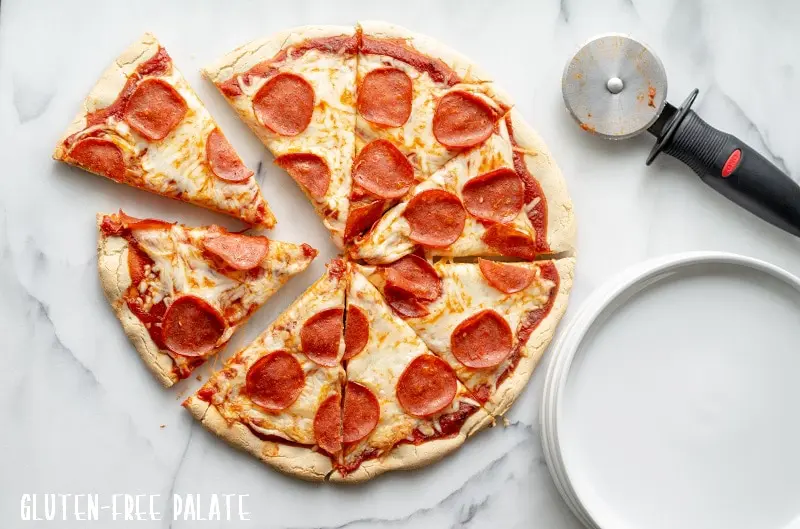
If you love pizza, you'll also enjoy these delicious Gluten-Free Cheesy Bread Sticks. Don't miss out on the fun-sized Gluten-Free Pizza Rolls, perfect for any gathering and super kid-friendly. And if you're into the classics, this Homemade Gluten-Free Pasta offers a pasta base for various dishes. For dessert, have you ever tried a Gluten-Free Fruit Pizza? (It's amazing!)
Don't feel like making your pizza from scratch tonight? Then check out these Best Gluten-Free Frozen Pizza Brands You Need To Try!
Gluten-Free Pizza Dough Crust Recipe
Perfectly thick and chewy, with no kneading required, this quick and straightforward gluten-free pizza dough crust recipe will have you adding gluten-free pizza to your regular meal rotation.
This recipe is your secret weapon when you need a dinner that will be eaten, as the taste is just that good, especially with picky eaters. My children come to the dinner table quickly as they realise what's for dinner and these go down so well. Make sure to use your children's favorite toppings. I tend to tone down the garlic and spices, so there are no complaints or leftovers.
I must confess, though, that I tend to double or even triple this recipe so I can have leftovers for lunch the next day. I even freeze a few dough balls for a seamless dinner when I have no idea what to make.
We use this gluten-free pizza recipe several times a month and have passed it on to friends and family members to show them how easy it can be to make your pizza at home. So say goodbye to takeout and hello to fresh, tasty pizza with your choice of toppings and seasoning.
Why You’re Going to Love These Gluten-Free Pizza Dough Crust
Easy and hassle-free preparation - This gluten-free pizza dough crust requires no kneading and can be made quickly with simple ingredients.
Deliciously thick and chewy crust - The resulting crust is perfectly thick and chewy, providing a satisfying texture that rivals traditional pizza crusts.
Versatile and customizable - You can add your favorite toppings and sauces to create a pizza that suits your preferences, making it a versatile option for satisfying your pizza cravings.

Ingredients in Gluten-Free Pizza Dough Crust
Gluten-free flour blend - The gluten-free flour blend forms the base of the pizza dough and provides structure and texture. It typically consists of a combination of gluten-free flours and starches, such as rice flour, tapioca starch, and potato starch.
Yeast - Yeast is used for leavening the dough, creating air pockets, and contributing to a lighter texture in the crust. It helps the dough rise and adds flavor.
Sugar - Sugar acts as a food source for the yeast, helping it to activate and ferment, which leads to the rising of the dough. It also adds a touch of sweetness to the crust.
Warm water - Warm water activates the yeast and facilitates its fermentation process. It helps dissolve the sugar and allows the yeast to multiply and produce carbon dioxide, which causes the dough to rise.
Olive oil - Olive oil adds moisture and richness to the dough, enhancing its flavor and texture. It also helps to keep the crust tender and prevents it from drying out.
Salt - It helps regulate the fermentation process and strengthens the gluten-free dough structure.
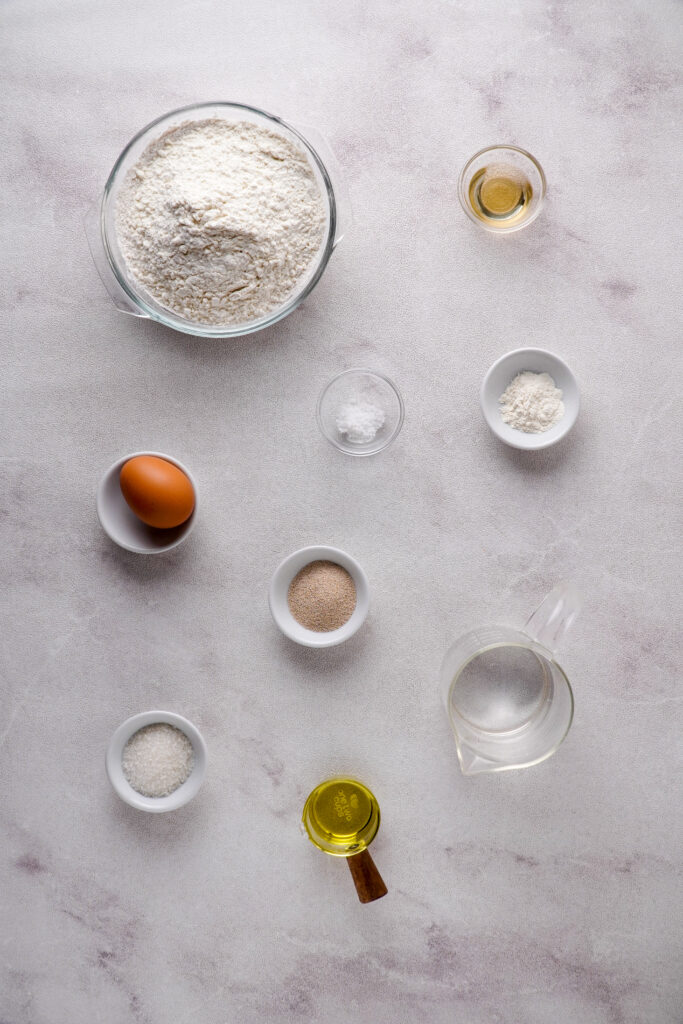
Equipment Needed for This Gluten-Free Pizza Dough Crust
This equipment will ensure you have everything you need to prepare and bake the gluten-free pizza dough crust successfully.
Mixing bowl - A mixing bowl is required to combine and mix the ingredients together.
Mixer (optional) - While it's not totally necessary, a stand mixer can make the mixing process easier and more efficient. It helps to thoroughly combine the ingredients and create a cohesive dough.
Baking sheet or pizza stone - A baking sheet, pizza pan or pizza stone is used to place the pizza crust and bake it in the oven. A pizza stone can help create a crisper crust by evenly distributing heat.
Parchment paper - Parchment paper is useful for rolling out and shaping the dough. It prevents sticking and makes it easier to transfer the crust to the baking sheet or pizza stone.
Spatula or oiled hands - A spatula or oiled hands are helpful for handling the sticky gluten-free dough, spreading it into a circle, and transferring it onto the baking sheet or pizza stone.
Pizza cutter or knife - A pizza cutter or knife is used to slice the baked pizza into portions for serving.
If you have any questions about making Gluten-Free Pizza Dough Crust, please leave a comment, and we will get back to you as soon as possible.
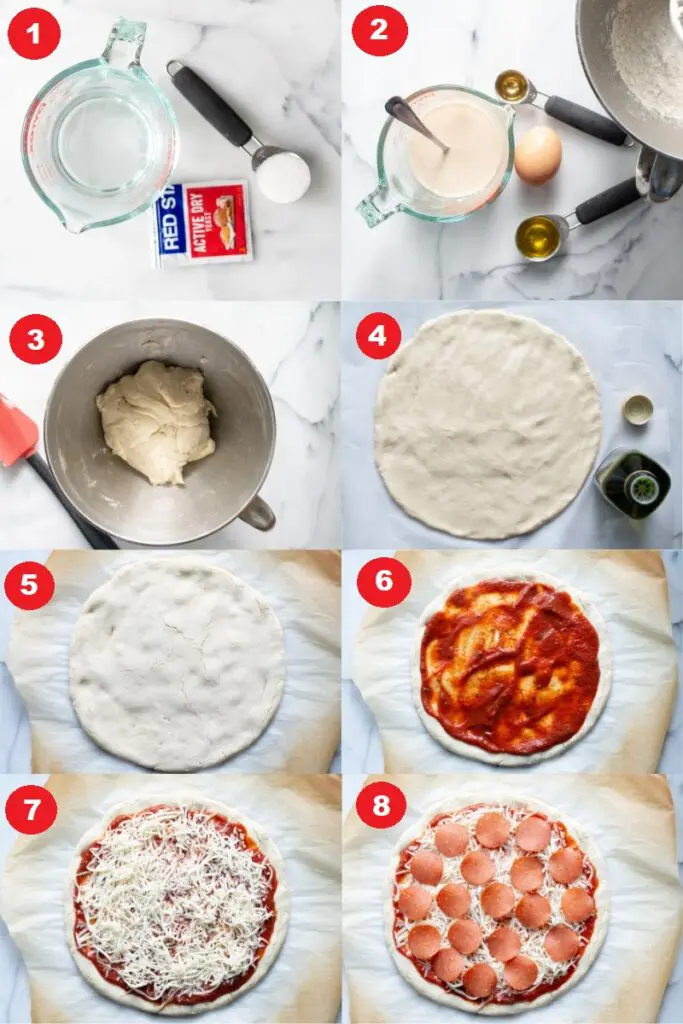
How to Make Gluten-Free Pizza Dough Crust and Gluten-Free Pizza
- Mix your warm water, sugar, and yeast. Let it sit until proofed.
- Add ingredients to a mixer and mix until combined.
- Scrap the sides of the bowl until the dough is in a loose ball.
- Using oiled hands, spread the dough into a circle about 10-12 inches in diameter.
- Bake for 8-10 minutes or until the center is set. Remove from the oven. (Note the high-altitude baking tips, too).
- Spread marinara sauce (or sauce of choice). Leave a little bit of space between the sauce and the edges.
- Sprinkle on the cheese of choice.
- Add any additional toppings and place them back in the oven. Bake for 8-10 minutes or until the cheese is melted and turns brown.
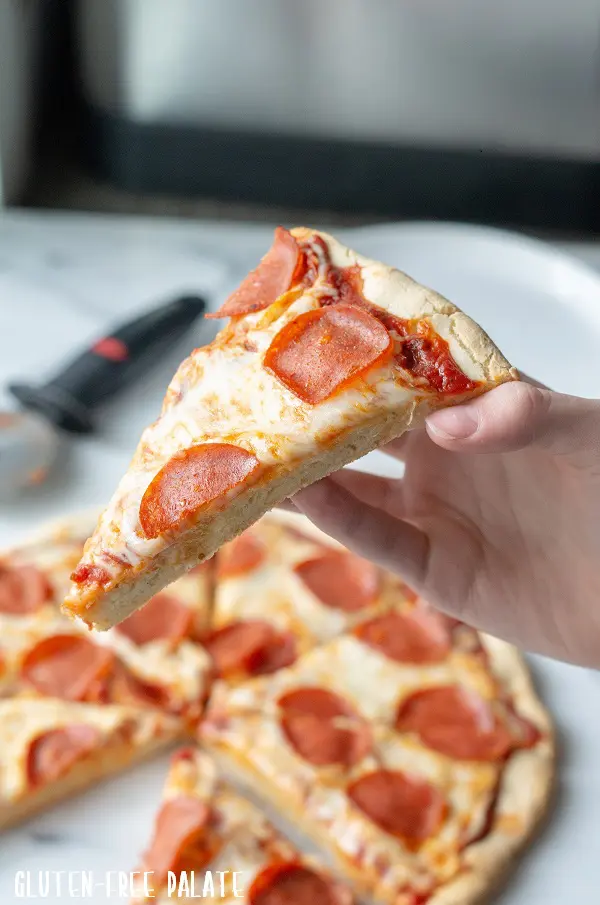
Tips for Making the Best Gluten-Free Pizza Dough Crust
Use a high-quality gluten-free flour blend - Invest in a reliable gluten-free flour blend. This ensures the right texture and structure in your crust.
Add xanthan gum - A binding agent helps mimic the elasticity of gluten and improve the dough's ability to hold together, resulting in a less crumbly crust.
Pre-bake the crust - To achieve a crispier crust, pre-baking the dough for a few minutes before adding toppings. This helps create a barrier and prevents the crust from becoming soggy.
Oil hands and utensils - Gluten-free dough tends to be stickier, so keep your hands and utensils well-oiled when working with the dough. This prevents sticking and makes shaping the crust easier.
Use a pizza stone or preheated baking sheet - If you have one, preheat a pizza stone or baking sheet in the oven. These heat-retaining surfaces help create a crispy crust by evenly distributing heat.
Don't overload the crust with toppings - Avoid overloading the crust with too many toppings, as this can make the crust soggy. Use a moderate amount of sauce, cheese, and toppings for a balanced and well-cooked pizza.
Bake at a high temperature - Bake your pizza at a high temperature, typically around 450°F (230°C) or higher. This promotes browning and helps create a crispier crust.
Let the pizza cool slightly before slicing - Allow the pizza to cool for a few minutes before slicing. This helps the crust set and prevents the toppings from sliding off.
Experiment and have fun - Gluten-free pizza dough crust can differ from traditional dough, but don't be afraid to experiment with different flours, seasonings, and toppings to find your favorite combination. Enjoy the process, and have fun creating your own gluten-free pizza masterpieces!
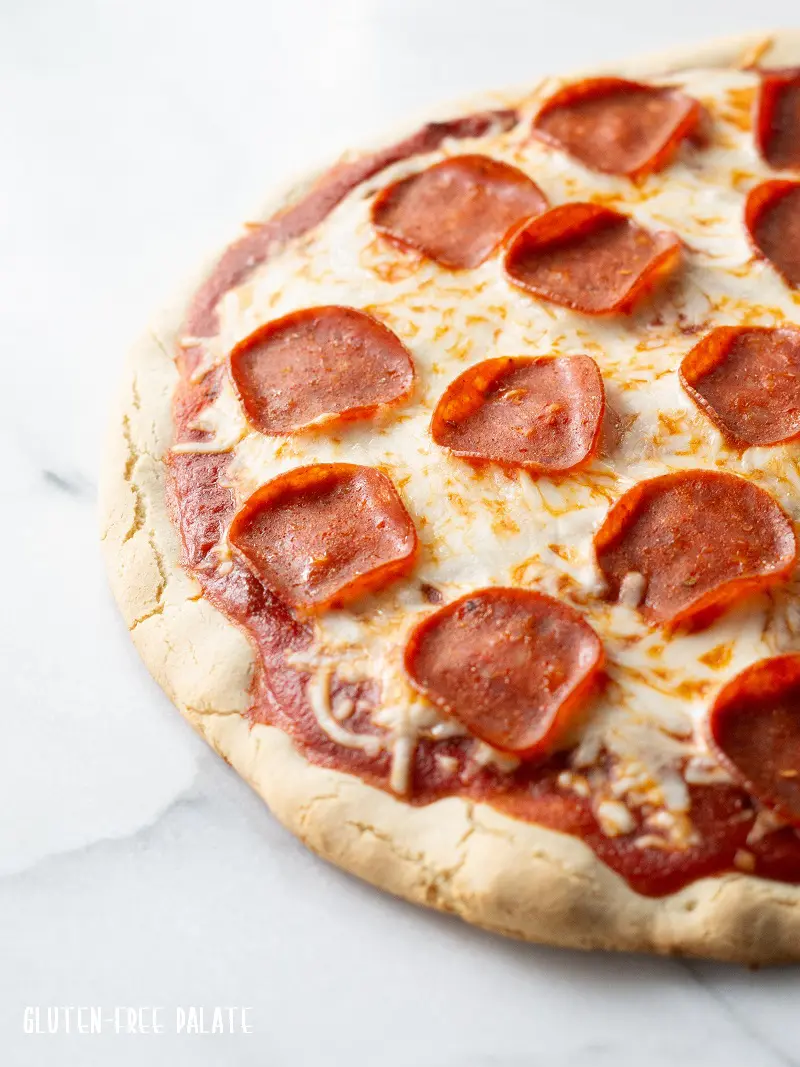
Frequently Asked Questions
How Do I Store Gluten-Free Pizza Dough Crust?
To store gluten-free pizza dough crust, I suggest you par-bake the crust, and then you can keep it in the refrigerator for 2-3 days until you are ready to use it. Ensure it is well-sealed to maintain freshness. Add your topping to the gluten-free pizza base and enjoy! You can also store your leftover pizza in the fridge for 2-3 days and reheat it as you choose.
Can I Freeze Gluten-Free Pizza Dough Crust?
Follow the steps in the recipe card until you have parbaked the crust. Place the crust in a freezer-safe bag or wrap it tightly in plastic wrap, ensuring it is well-sealed. Label the bag with the date and freeze it for up to 3 months. When you're ready to use the frozen pizza crust, transfer it to the refrigerator and let it thaw overnight. Proceed with adding toppings and baking the crust as desired.
We usually par-bake a couple of extra gluten-free pizza crusts and store them in the freezer for super busy nights when we need to make dinner quickly. Simply pull a crust from the freezer, heat your oven, top, and bake, just like store-bought pizza crusts, only better.
Can You Make This Gluten-Free Pizza Dough Crust Ahead of Time?
Yes, you can make this GF pizza dough crust ahead of time. Parbake it, and then you can refrigerate it for 2-3 days and then bake it with your toppings of choice, or freeze the gluten-free crust and defrost it when needed. Making the pizza crust ahead of time allows for convenient meal planning and can save time when you're ready to make the pizza.
Can I Substitute Something For The Egg In The Gluten-Free Pizza Dough Crust?
Sure, you can use a flax egg (2.5 tablespoons water + 1 tablespoon ground flax seed) to make the gluten-free pizza dough. Make sure to let your flax egg sit for 5-10 minutes until it gets thick and egg-like.
Just note that the crust won't be fluffy in the center. I haven't tried other egg replacers in this recipe.
Can I Bake This Gluten-Free Pizza Crust Without A Pizza Stone?
First, I highly recommend getting a pizza stone if you don't have one. It really makes a huge difference when you make gluten-free pizza.
But no worries. If you don't have one, simply use a heavy baking sheet. If you don't have a heavy baking sheet, then you can use a cookie sheet. Let it preheat in the oven just as you would a pizza stone. You can do this before you make your gluten-free pizza dough.
What Can I Do If My Homemade GF Pizza Crust Is Soggy?
If you find that your gluten-free pizza crust is turning out soggy, here are a few tips to help improve its texture:
Pre-bake the crust - Pre-baking the crust for a few minutes before adding the toppings can help create a barrier and prevent excessive moisture from seeping into the dough. This step helps to achieve a crisper crust.
Use less sauce - Excess sauce can contribute to a soggy crust. Try using a lighter amount of sauce, or consider using a thicker sauce to help control the moisture content.
Drain and pre-cook toppings - Some toppings, such as vegetables or meat with high water content, can release moisture during baking, making the crust soggy. To prevent this, drain any excess liquid from the toppings before adding them to the pizza. You can also consider pre-cooking the toppings slightly to remove moisture.
Increase oven temperature - Ensure your oven is preheated to a high temperature, usually around 450°F (230°C). Baking the pizza at a higher heat helps to evaporate excess moisture and crisp up the crust.
Use a pizza stone or baking sheet - Using a pizza stone or baking sheet can help to distribute heat evenly and absorb moisture, resulting in a crisper crust. Preheat the stone or steel in the oven before placing the pizza on top.
Thinner crust - If you prefer a crisper crust, try rolling out the dough thinner before baking. A thin crust tends to cook more evenly and have a better chance of staying crisp.
Can I Use A Toaster Oven To Make Pizza?
I have never used a toaster oven to make pizza, but I have used one to reheat pizza.
If you make this gluten-free pizza dough in a toaster oven, please come back and tell me about your experience.
If I ever make this gluten-free pizza dough in a toaster oven, I'll make sure to update this post with my results.
Gluten-Free Dairy-Free Pizza
This gluten-free pizza dough recipe is already dairy-free. It uses olive oil. You can top this pizza crust with your favorite dairy-free cheese to make a gluten-free dairy-free pizza.
Another option is to leave the cheese off together and brush on some dairy-free butter and sprinkle it with garlic salt after it's cooked.
Can I Use Almond Flour To Make This Pizza Dough Recipe?
While almond flour can be a great option for many gluten-free recipes, including some pizza crusts, it may not be the best choice for this particular GF pizza dough recipe. This recipe relies on a blend of flours and starches to achieve the desired texture and structure. Almond flour alone may result in a crust that is too dense and crumbly.
What other flours can I use in this gluten-free pizza crust recipe?
I have tested this gluten-free pizza crust recipe with Bob's Red Mill 1-to-1 Gluten-Free Flour Blend. It works incredibly in this recipe, and it's my other go-to flour blend.
If you want to mix your own blend for this pizza (per my original recipe), combine 1 cup white rice flour, ¾ cup brown rice flour, and ¼ cup tapioca starch.
I haven't tried this gluten-free pizza dough recipe with other flour blends. If you do, please return and let me know which gluten-free flour blend you use.
Can I Use This GF Pizza Dough Recipe To Make Gluten-Free Breadsticks?
Yes, you can use my gluten-free pizza dough recipe. I have made a recipe for gluten-free cheesy breadsticks using the same ingredients and techniques as this gluten-free pizza recipe. The only difference is the toppings.
What To Do If Your Gluten-Free Pizza Crust Is Crumbly?
If you find that your gluten-free pizza crust is turning out too crumbly, here are some tips to help improve its texture:
- Check your flour-to-liquid ratio - Too much flour in the dough can make it dry and crumbly. Add more liquid, such as warm water or olive oil, to the dough mixture to achieve a slightly softer and more pliable consistency. But please ensure you are measuring correctly, as this can be the main cause.
- Check you have added the binding agent - The binding agent in the gluten-free dough helps hold the ingredients together and prevents crumbliness. Check you have added in xanthan gum if your flour blend does not have it.
- Handle the dough gently - Gluten-free dough can be more delicate than traditional dough, so handle it carefully. Avoid overworking or kneading the dough too much, as this can lead to a crumbly texture. Mix the ingredients until just combined, and handle the dough gently when shaping it into a crust.
Remember that gluten-free dough can be slightly different from traditional dough, and it may require experimentation to find the right techniques for the best results.
Why Is My Gluten-Free Pizza Dough Sticky?
Yep, most gluten-free pizza dough is sticky. Simply use an oiled spatula to transfer the gluten-free pizza dough from the bowl to your parchment paper.
Then rub some oil on your hands before you spread the dough.
Looking for more GF recipe ideas? Check out our 55+ Best Gluten-Free Recipes.
What Toppings Can I Place On My GF Pizza Crust?
Here's some of my favorite pizza topping ideas:
- Fig and prosciutto
- Apple slices, brie, and bacon (my personal favorite)
- Caramelized butternut squash and kale
- Four cheese pizza (mozzarella, parmesan, gorgonzola, pecorino)
- Buffalo chicken
- Greek pizza (feta, olives, tomatoes, red onion)

Click here to view our step-by-step video for this recipe on YouTube.
Gluten-Free Pizza Dough Crust
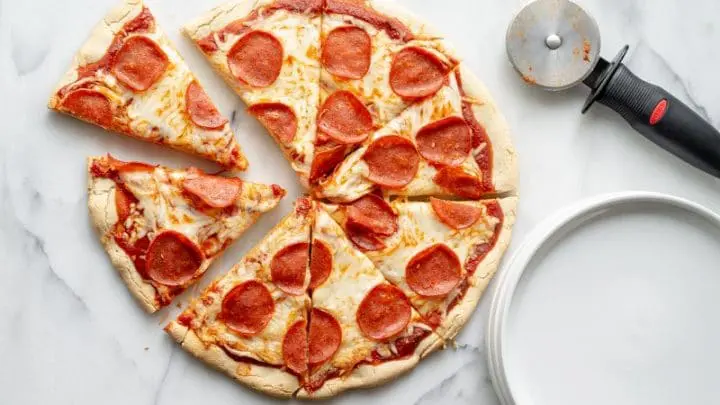
My go-to Gluten-Free Pizza Crust recipe is a simple staple for your Gluten-Free kitchen. Perfectly thick and chewy, and no kneading required.
Ingredients
- ¾ cup warm water (between 110-120 degrees F)
- 1 tablespoon sugar
- 1 packet yeast (¼ oz.)
- 2 cups (285g.) gluten-free flour blend
- 1 teaspoon xanthan gum (if your flour blend does not already contain it)
- 1 teaspoon salt
- 1 large egg
- 1 tablespoons olive oil
- 1 teaspoon cider vinegar
Instructions
- Set pizza stone or heavy baking sheet on lowest rack of oven, and preheat to 450°F.
- Mix water, sugar, and yeast and let sit for 5 minutes, or until it looks foamy.
- In electric mixer bowl, mix flour blend and salt. Add in egg, olive oil, vinegar, and yeast mixture.
- Mix on low speed for 1 minute.
- Using an oiled spatula, transfer the gluten-free pizza dough onto a piece of parchment paper. Using oiled hands, spread dough into a 10-12-inch round.
- Bake for 8-10 minutes.
- Add toppings and bake for an additional 8-10 minutes.
- Enjoy hot.
Notes
- Working with or measuring gluten-free flour: spoon the flour into the measuring cup and level. Do not scoop your measuring cup into the gluten-free flour. The best method really is to weight it but I don't have the ingredient weights for all my recipes yet.
- Yeast: This recipe works with active yeast and instant yeast.
- Oil: If you don't have olive oil you can use your oil of choice.
- Gluten-Free Flours: This recipe works with several types of gluten-free flour blends but we find that our homemade gluten-free flour blend and Bob's Red Mill 1-to-1 Gluten-Free Baking flour work best in this recipe.
- Mix your own flour: If you want to mix your own blend for this pizza combine 1 cup white rice flour, ¾ cup brown rice flour, ¼ cup tapioca starch.
- Rising: You don't have to let the dough rise, it will rise in the oven, but you can let it rise for up to 30 minutes for a fluffier pizza crust.
Recommended Products
As an Amazon Associate and member of other affiliate programs, I earn from qualifying purchases. They never cost you extra.
-
Anthony's Instant Dry Yeast Packets, Contains 42 Individual Packets, Gluten Free
-
KitchenAid Artisan Series 5 Quart Tilt Head Stand Mixer with Pouring Shield KSM150PS, Aqua Sky
-
Kitchy Pizza Cutter Wheel with Protective Blade Cover, Ergonomic Pizza Slicer (Green)
-
Bob's Red Mill Gluten Free 1-to-1 Baking Flour, 22-ounce (Pack of 4)
-
Augosta Pizza Stone for Oven and Grill, Free Wooden Pizza Peel paddle, Durable and Safe Baking Stone for grill, Thermal Shock Resistant cooking stone, 15 x 12 Inch
Nutrition Information:
Yield:
8Serving Size:
8Amount Per Serving: Calories: 87Total Fat: 2gSaturated Fat: 0gTrans Fat: 0gUnsaturated Fat: 2gCholesterol: 23mgSodium: 275mgCarbohydrates: 14gFiber: 0gSugar: 2gProtein: 2g
This nutrition info is based on the exact ingredients and brands used at the time. It may not be 100% accurate. Please check your ingredients nutrition labels.







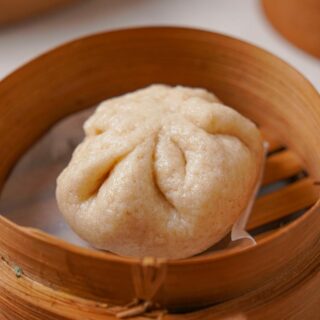
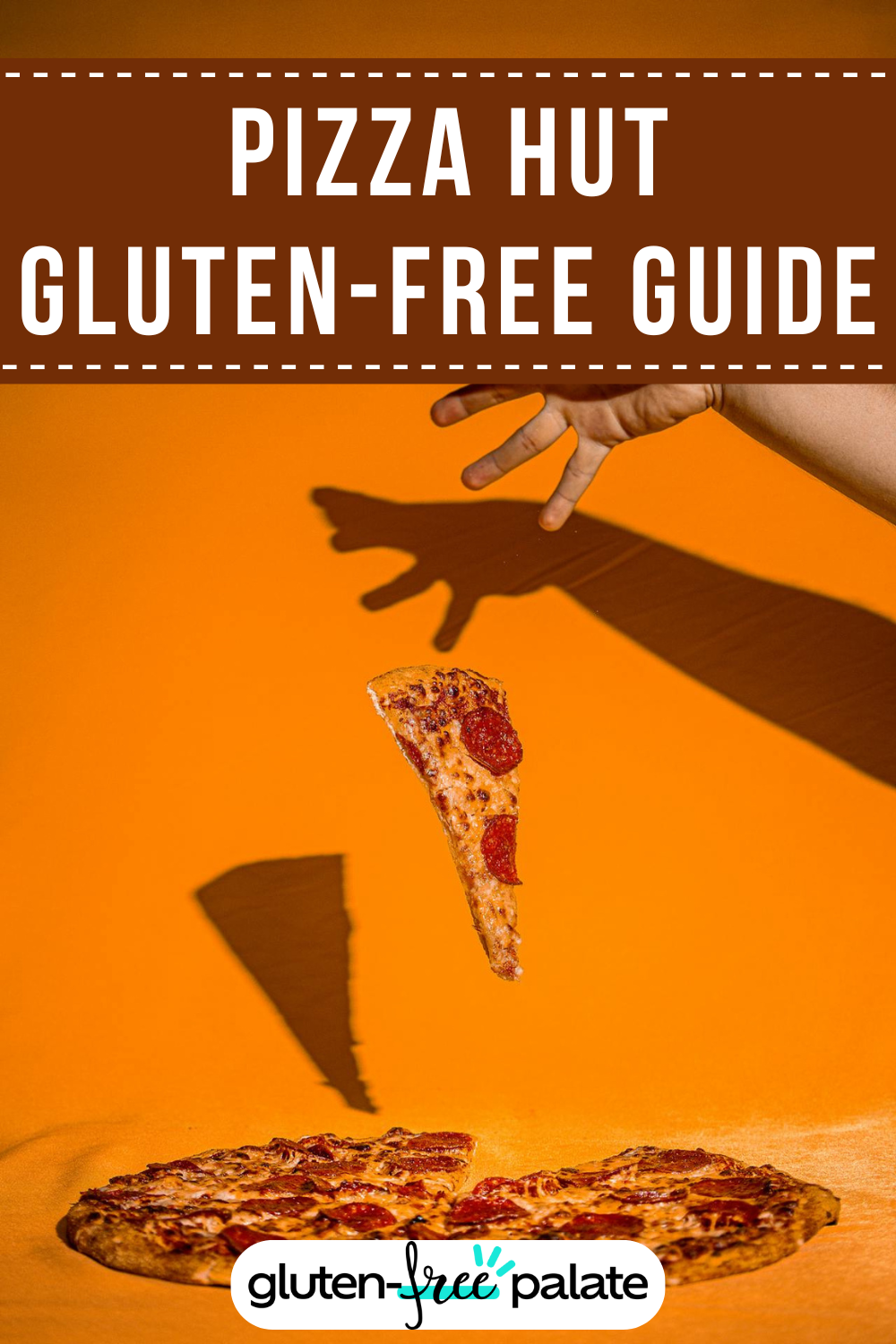
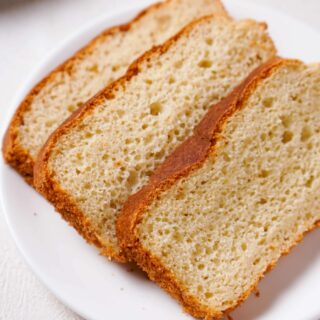

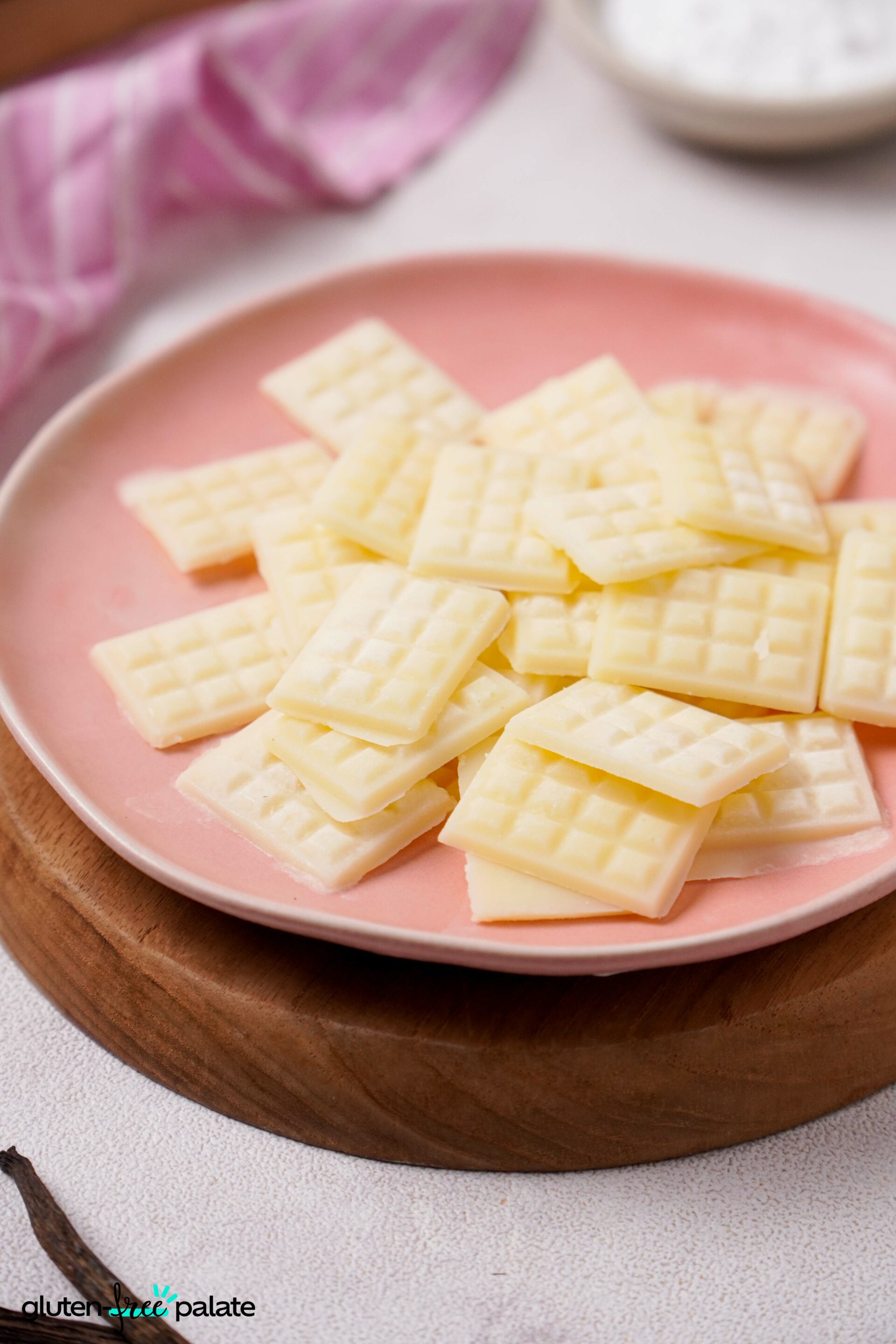

Vanessa
Hello, thank you for the recipe. I did make a flour modification. You wanted your audience to know how it turned out. I used 1/2 cup modified tapioca starch, and 1 1/2 cup of better batter artisan flour. Everything else about same with exception i used kosher salt rather than table salt. It turned out nice and bubbly like we love. The flavor was out of this world! We planned on a taco pizza and it is gonna be so yummy.
chrystal
Thank you so much for stopping back by and sharing what you used. It helps others 🙂
Best,
Chrystal
Mary
Really great! Thank you
Sharon Mackenzie
Best gluten free pizza dough recipe ever-I used Bobs Red Mill 1 to 1 flour. I put the dough on a piece of parchment paper-it will be quite sticky-then using my fingers worked it to a 12 inch circle and then put the parchment paper directly onto my pizza pan. I did exactly what the recipe said and we loved it!
Lindsay
Hi Sharon!
We are so glad you loved it! Thanks so much for sharing your tips - you're right, the dough can be sticky, you just have to work with it carefully 🙂 Parchment paper works well.
Michelle
Any tips on making a big batch of dough and freezing it for future use?
Wendy Stoltz
Hi Michelle, I would double the recipe. I would also suggest baking the bases for 15 minutes, letting it cool to room temp, then freezing. It will last 3 months in the freezer and you can pull it out, add toppings, and bake for another 10+ minutes.
Marci
Yum! I just made this and it came out great. I was surprised how easy it was and I had all the ingredients on hand. I sprayed the spatula with Pam olive oil spray and spread in pan with spatula and hands, super easy. Thanks!
chrystal
You are very welcome. I am so glad you liked it.
Best,
Chrystal
Sarah
Hi! This turned out great! Can I freeze the dough prior to baking or should I pre bake and then freeze?
Lindsay
I like to par-bake the crusts and then freeze them. Enjoy!
Ashley
Yum! Looks delicious! Will the dough come out if so mix by hand? How should I prepare if si don’t have a stand up mixer?
chrystal
You can mix it by hand.
Best,
Chrystal
MAGGIE GALLAGHER
Can I double the recipe? And if so, do I double all ingredients?
chrystal
Yes and yes 🙂
Christina
Hello, once the dough is rolled out in the suggested diameter, can it be placed in the freezer for later use? If this can be done how long would freezer life be?
chrystal
I recommend baking it for 15 minutes, letting it cool to room temp, then freezing. It will last 3 months in the freezer and you can pull it out, add toppings, and bake for another 10+ minutes.
Best,
Chrystal
Jeannette
If I'm spreading it on parchment paper how does that work with using a pizza stone?
chrystal
You slide the parchment paper onto the hot pizza stone. The paper will turn brown, but will be fine as long as the baking rack is on the bottom or middle setting and not too close to the top coils.
Best,
Chrystal
Kat
My crust didn’t stick at all. Is there I can do, I just coconut flour
Lindsay
Hi Kat, I'm not exactly sure what you're asking. The recipe won't work with just coconut flour, you need to use a flour blend that includes rice flour. Coconut flour on its own isn't the best choice for making gluten free breads.
Jen
This turned out great and was so easy! I used Great Value Walmart brand flour. Do you know if you can use this recipe with regular (non gluten free) flour?
chrystal
I haven't tried it with regular flour, but it should work.
Best,
Chrystal
Holly
Thanks for the recipe! Does the egg need to be room temp?
Lindsay
Hi Holly!
It's helpful when all of the ingredients are at room temperature. They incorporate better that way. You can quickly get an egg to room temperature by putting it in a bowl of slightly warm water for a few minutes.
Shirley
This is a disaster!! I had to add tons of flour and still a goopy mess. I’ve been GF baking for years now and never had a bigger mess. This isn’t pizza dough, it’s batter!!
Lindsay
Hi Shirley,
Thanks for the comment, and I'm sorry that the recipe didn't work out for you. A handful of other readers have mentioned liquidy results when making flour substitutions. If you've made any substitutions, that might be the issue? If you could let me know, we can troubleshoot.
Charlotte
Do I need xanthan gum if my flour doesn't have it?
Lindsay
I typically would add 1 teaspoon of xanthan gum per cup of flour for dough recipes. You can try it without, but the texture will not be quite right. Enjoy!
Randee
Making this for the second and I cannot believe how easy it is. I use a pizza screen and cover with foil for the first bake. I slide it off and cook directly on the screen for the second bake with toppings and it turns out lovely. Thank you!
Lindsay
Thank you so much for stopping back to let us know how it went!
Lauren
huge pizza lover and I just can't believe that now to order gf pizza it's easily $20! Decided to give making my own a try...SO delicious (better than the restaurants!), SO easy, and much more affordable!
Lindsay
Thanks Lauren! So glad you loved it.
Christina
When I double the recipe, do I need to double the yeast? I’ve made this once before and it turned out great!
Lindsay
Glad you like the recipe! Yes, you should double all of the ingredients if you're doubling the recipe. Enjoy!
Dorothy
We LOVE this crust! We use a flax egg and it's still delicious. If I remember to, I add garlic powder and oregano to up the flavor of the finished pizza. My favorite part is using your listed flour mix as all 3 are easy to find and much cheaper than special ones. And no gums required! I now have a special bin with your flour mix just for pizza since we make it so often now!
Thank you thank you!
Lindsay
Dorothy - this comment makes me smile! Thank you so much for coming back to let us know how much you love the recipe. Garlic powder and oregano sound amazing, I'll have to try that next time!
Veni Rea
Amazing! I added some garlic to the mix because I'm that girl. So impressed! Thank you!
Lindsay
Hi Veni! You go ahead and be that girl! Garlic is perfect in pizza crust. So glad you like the recipe 🙂
Livia Antonacci
I am a pizza lover and have been making regular pizza for years now. I really don't need to make it Gluten Free but I am going to try it anyway to see how it comes out. I think I am going to use only Bob's red mill gluten-free flour before I add others to this recipe.
Thank you for all the suggestions!!!
Lindsay
Awesome! I hope it's amazing 🙂
Karen Koehn
How is the quality if I let it cool to use with a veggie or fruit pizza?
Lindsay
We haven't tried using this crust in that way, but I think it would work well. Please try it and come back and report!
Angela Bucciarelli
Hi, I live at high altitude. What changes/adjustments should I make?
Thanks.
Lindsay
Hi Angela, this isn't something I know enough about but would suggest that you use the common adjustments for high-altitude baking. At higher altitudes, yeast doughs will rise more quickly, so be sure to check on the crust earlier, and increase the oven temp a bit to help with that. We'd love to hear more about your experience if you experiment with the recipe!
Rosie T
I haven't had pizza with bready crust in so long! This turned out wonderful! I wanted good, homemade pizza for my birthday and this was just the ticket. I didn't use a mixer and it turned it fine. I also oiled my hands, rather than the spatula to put it on the paper/pan. Similar to many GF recipes, this isn't a true dough, but more of a spreadable batter, which I expected, since I've been baking GF for 10 years. This one is going in my favorites!
Lindsay
So glad you loved it! Thanks so much for coming back and sharing your experience!
Pam Keesee
I tried your recipe for the pizza crust last night, and it was soupy! I had to add nearly a cup of regular flour (used up the GF flour) before I could get
it into a ball! I used King Arthur brand GF All purpose flour, and followed the recipe exactly. What do you think went wrong?
Lindsay
Hi Pam, Typically when others have had the dough be too wet it has to do with substitutions not being quite right. You may have better luck using a different GF flour blend. You may also not need to add all of the liquid next time. Also keep in mind that this dough is fairly wet, and won't have the texture of a traditional pizza dough.
Gayle
Best ever! Thank you so much for the pizza dough recipe. I have tried numerous ones and yours was by far the best.
Lindsay
Thanks so much Gayle!
Wanda
Made this today when I didn't have a ready-made one on hand. It turned out great! I also used the Bob's 1-to-1. Mine didn't come out as pretty as yours, but it tasted wonderful! I will be making it again.
Lindsay
Hi Wanda! So glad you liked it. It's definitely a recipe that you'll be making again and again.
beachy
Can you bake directly on the pizza stone? My parchment paper says to only use up to 425 degrees.
Lindsay
Hi there! Yes, you can bake directly on the stone if you like. I think that using parchment makes it easier to move the pizza, but either way is fine.
Emily Franchi
Can I make this ahead and refrigerate?
Lindsay
Hi Emily,
We haven't actually tried refrigerating the unbaked pizza dough. It's really best if used right away. If you need to, you can bake it without toppings for 10-15 minutes, and then store the crust in the fridge for a few days or in the freezer for a few months.
Elaine Huntsinger
Excellent and easy! We really enjoyed it a lot. After reading other comments, want to say dough was of good consistency and very easy to spread with oiled fingers
Lindsay
Hi Elaine, Thanks so much for the comment! You are right, a little bit of oil is very helpful 🙂 Glad you enjoyed your pizza!
Brenda
I made this recipe yesterday using Bob's Red Mill All Purpose GF Flour Blend, which required adding Xantham Gum to the dry ingredients (per the Bob's website). Otherwise, I followed the recipe exactly as written. I didn't have any issues with the mixture being too wet, and oiled my hands to press the dough into the required size. I baked it at the right temp, etc. using a pizza stone. Overall, this was a really excellent pizza crust. I think the very center may have been a bit underdone. Next time, I think I will try placing the baking rack one notch higher, and possibly going a bit longer for each bake time to insure the whole crust is fully baked. Oh, and a pizza peel would be great because trying to get things in and out of a very hot oven (on a piece of parchment no less) was tricky. I will definitely be making this again.
Lindsay
Hi Brenda! So glad you enjoyed the pizza, and thank you so much for your review and details of your experience.
Karen Ratzlaff
I used Robin Hood general flour. Only difference it has xantham gum added. I found the dough quite dry. Would this be from using the Robin Hood flour? Have trouble finding the Bob's Red Mill flour you recommend.
Lindsay
Hi Karen, All gluten free flours are different, so sometimes you'll need to experiment with different flours. I suggest using less flour next time you make the dough and see how that works.
Lynda
Recipe worked well with Robin Hood GF flour from Walmart.
I am looking to make pizza pockets that I can put in the freezer for my son to take out and reheat in the toaster oven.
I am going to try putting the raw dough in muffin tins. I will precook dough in tin for 8 min. Then, I will add filling and some dough on top. I thought I could use a cookie cutter to make the topper the right size.
Unless someone has another idea that might work.
Lindsay
Hi Linda! Glad that the recipe is working well for you! You could try making hot pocket-style rectangular shapes if the muffin tin idea doesn't work out. Let us know!
Jamie
This turned out great! My husband can’t have brown rice flour, so we used Bob’s Red Mill white rice flour + 2 tsp xanthan gum. Definitely a keeper!
Lindsay
Yay! So glad it worked so well for you. Thank you for letting everyone know about the substitutions you tried too, it's so helpful!
patti
I loved this recipe! I put the dough in my cast iron skillet and left it in the oven for about 12 minutes instead of 10. I used King Arthur gf flour and am happy to say I can finally eat a pizza that I love! Thank you!
Wendy Stoltz
Hi Patti,
I am so happy you loved the recipe. It is a nice feeling to be able to eat something you love!
Kim
I made the crust as is with Bob Red Mill GF 1:1. I got so use to crispy/thin crust I flattened this one out like that as well. It did seem to have a undone look to it. But the outer showed browning so it was done I guess. Is that normal? The undone look? Also I didn't measure it but Id say it was between 15-16" Thoughts? The Mr. doesn't like the "undone" look. Tasted great though. I added garlic and onion powder to the crust. Really flavorful.
Wendy Stoltz
Hi Kim, The only thing I can think of is that your oven is perhaps not cooking it enough. Some ovens don't heat up to temperature. You could always get an oven thermometer if needed.
Barbara
Incredible...so good.
I used Bobs 1 to 1 and followed directions exactly except I just oiled my pizza sheet and spread the dough - no parchment paper needed.
Wendy Stoltz
Thanks Barbara, I am so glad you enjoyed it!
Dee
Absolutely the very best pizza crust ever! I served it to family and did not even say it was GF. They went crazy over it. I managed to save a slice to see how it would be reheated... I imagine wonderful or I'll just eat it cold for breakfast!
Thank you so much!
Wendy Stoltz
Hi Dee, well done on your pizza success. It is so much easier when you can make gluten-free for everyone.